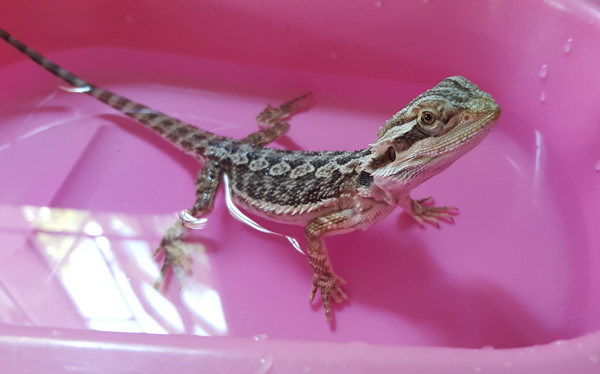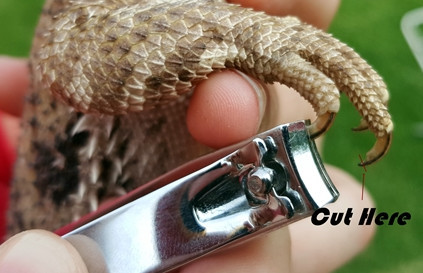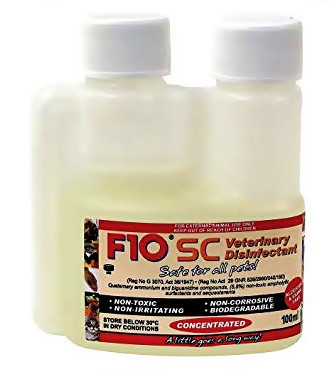Hygiene is a very important factor when it comes to bearded dragons. Keeping them and their habitat clean is key to preventing illnesses and diseases for them and for you. There are a few things you need to do regularly, in order to keep everything clean and sanitary.
Bathing
Bearded dragons need to be bathed on a regular basis to not only prevent parasites and mites but to keep them clean and bacteria-free. A bath once a week, which includes a gentle scrub with a soft toothbrush, will do the trick for them. Make sure to wash their “bum area”, because sometimes excrement will get stuck and cause parasites.

Nails
Clipping a bearded dragon’s nails is important because if it gets too long it will start to curve and bend inwards towards the toe, which can cause pain and discomfort. The nails should be clipped once every six weeks or when they start getting too long.
When clipping the nails, you only take off the point, but be careful to not cut where the live tissue is. The point where dead tissue ends and live tissue starts can be identified by a line or slight change in color.

Mouth and Teeth
A bearded dragon’s mouth should be kept clean to avoid bad breath and mouth rot. This can be done by feeding them apples or by brushing their teeth with a baby toothbrush. Be very careful to not hurt their gums, and if you have doubt, rather feed them a slice or two of apple every second day.
Bearded Dragon Cage Hygiene
This is where it gets tricky. It all depends on the type of Cage setup you have. Some setups will require more cleaning than others. For instance, wooden cages will require a good scrub more often than glass or melamine ones. Sand substrate is a breeding ground for bacteria and thus, a cage with sand as a substrate will have to be scrubbed at least once a week and sand replaced quite often.
My favorite kind of Substrate is fake grass, super easy to keep clean on a daily basis, and removing and scrubbing it only takes a few minutes. In addition, it dries quickly outside and the rubber-like bottom does not allow for poop to seep thru into the wood or melamine. By far my choice when it comes to ease of cleaning the substrate in the cage and still keeping them warm, especially during cold winter months.
Tip: I usually scrub their carpets and clean the cages at night when they are asleep. Hang the carpets on a rack and in the morning they are dry and ready to go into the cages. It works even better if you have 2 carpets for each cage, then you can simply just swap them out.
How Often Should I Clean the Cage/Tank?
A Quick Daily Clean
A quick, but thorough cleaning should be done every day. This includes removing poop, old food and anything else that is not supposed to be in there. Then a good vacuum to remove dust and so forth, after which you give the cage a wipe down with a wet, clean cloth.
A Proper Cleaning
Proper cleaning should be done once every two weeks. It can take a bit of time so make sure to make room for this in your schedule. You will have to temporarily relocate your beardie to a window, another cage, or a spot where he/she can wait for their cage. Start by removing everything from the cage including the substrate. You will then have to wash everything, from the accessories to the substrate, and disinfect it. (Substrate that should be washed and disinfected includes carpet tile and so forth. Other substrates like sand and paper towels should be replaced.) Make sure to rinse everything out properly so no chemicals are left behind. Leave everything out to dry and air out while you clean the cage itself.
The cage should also be cleaned with warm water and soap solution after which you disinfect it and then wipe it out properly. Normal wood cages should be scrubbed more thoroughly, due to the fact that it is a growing ground for bacteria. Glass and melamine are a lot easier to clean because there are no gaps and open spaces for the bacteria to grow in, but should be scrubbed nonetheless. After this process, the cage should be left to air out, the same as the rest of the things. Once everything has been scrubbed, disinfected, rinsed, and aired out, you can put it back in its place so your dragon can go back and enjoy his clean home.
I recommend the F10 solution as a disinfectant because it is safer to use, seeing as it was made for animal use. Make sure no chemicals are left when you are finished, it can be very harmful to your dragon. Personally, I use bleach and rinse well afterwards.

Note: Make sure to put everything where it was, some dragons may stress out if their cages are changed and this will affect their appetite and health.
